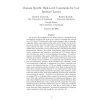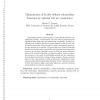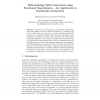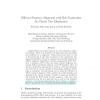CONSTRAINTS
2008
14 years 7 months ago
2008
Abstract. Essence is a formal language for specifying combinatorial problems, in a manner similar to natural rigorous specifications that use a mixture of natural language and disc...
CONSTRAINTS
2008
14 years 7 months ago
2008
We present the Auckland Layout Model (ALM), a constraint-based technique for specifying 2D layout as it is used for arranging the controls in a GUI. Most GUI frameworks offer layo...
CONSTRAINTS
2008
14 years 7 months ago
2008
CONSTRAINTS
2008
14 years 7 months ago
2008
The tree constraint partitions a directed graph into node-disjoint trees. In many practical applications that involve such a partition, there exist side constraints specifying requ...
CONSTRAINTS
2008
14 years 7 months ago
2008
Submodular function minimization is a polynomially-solvable combinatorial problem. Unfortunately the best known general-purpose algorithms have high-order polynomial time complexi...
CONSTRAINTS
2008
14 years 7 months ago
2008
Zinc is a new modelling language developed as part of the G12 project. It has four important characteristics. First, Zinc allows speci
cation of models using a natural mathematical...
CONSTRAINTS
2008
14 years 7 months ago
2008
CONSTRAINTS
2008
14 years 7 months ago
2008
We present a novel approach to automatically reformulating constraints defined as tables of allowed assignments to variables. Constraints of this form are common in a variety of se...
CONSTRAINTS
2008
14 years 7 months ago
2008
CONSTRAINTS
2008
14 years 7 months ago
2008
Aligning DNA and protein sequences is a core technique in molecular biology. Often, it is desirable to include partial prior knowledge and conditions in an alignment. Going beyond...




